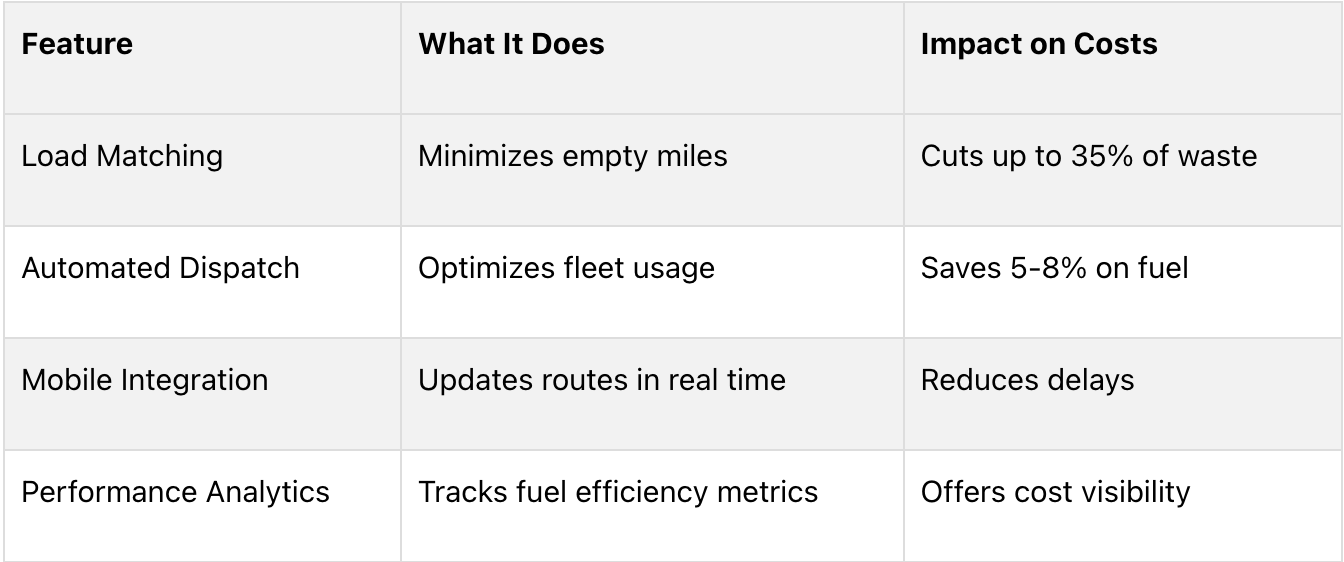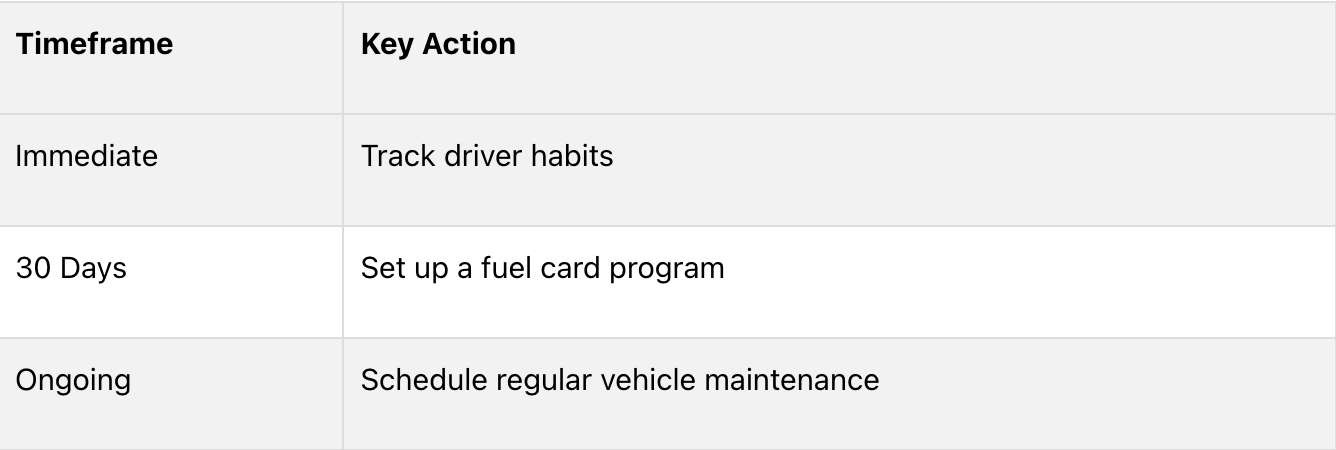5 Ways to Reduce Fuel Costs for Small Fleet Owners
Fuel costs can take up 30-40% of a small fleet’s budget. With diesel prices around $3.75 per gallon, cutting fuel expenses is crucial. Here are five proven strategies to save 10-20% on fuel costs:
- Smart Route Planning: Use GPS tools to optimize routes and reduce empty miles (save 5-10%).
- Driver Training: Train drivers to avoid wasteful habits like idling and harsh braking (save 3-7%).
- Fuel Card Programs: Access discounts and control spending (save 2-5%).
- Regular Maintenance: Keep trucks in top shape with tire checks, oil changes, and alignment (save 3-5%).
- Bulk Fuel Purchasing: Buy fuel in bulk or join group programs (save 2-4%).
Quick Tip: Start by tracking driver habits, setting up a fuel card, and scheduling regular truck maintenance. These steps can quickly improve your fleet’s efficiency and lower costs.
1. Use Smart Route Planning Tools
Cutting fuel costs starts with smarter route planning. Modern tools make it easier to improve efficiency and reduce waste.
Pick the Right GPS Software
Choosing effective GPS software can significantly lower fuel expenses. For example, systems like CloudTrucks automate dispatching, reducing empty miles and increasing overall efficiency.
Here are some key features to look for:

Monitor Live Traffic Data
Keeping an eye on live traffic is another way to avoid wasting fuel. Did you know vehicles stuck in traffic can burn up to 30% more fuel compared to those on clear roads?
Choose Fuel-Saving Routes
Smart route planning isn’t just about finding the shortest path. It's about choosing routes that save fuel.
Consider these strategies:
- Avoid steep inclines; this alone can save up to 20% on fuel.
- Minimize left turns, a tactic that helped UPS save millions of gallons annually.
- Combine route planning with telematics to uncover real-time adjustments. Many fleets recover the cost of these tools within a year through fuel savings.
Once you've nailed route planning, the next step is addressing driver habits for even more savings.
2. Train Drivers in Fuel-Saving Methods
How drivers operate vehicles has a big impact on fuel expenses. Studies show that training drivers can lead to fuel efficiency improvements of 5-15%.
Track Driver Performance
Using modern telematics systems, you can identify and address behaviors that waste fuel.

Set Up Driver Rewards
Incentive programs can encourage drivers to adopt fuel-efficient habits.
Key components of a good reward program include:
- Tracking metrics like idle time and speed compliance.
- Tiered rewards that increase with better performance.
- Monthly recognition to spotlight top performers.
- Team competitions to keep engagement high.
Set Speed and Idle Rules
Establishing clear speed and idle policies can significantly reduce fuel costs. For instance, driving 5 mph over 50 mph adds $0.18 per gallon to fuel expenses.
Effective policies might include:
- A highway speed limit of 65 mph.
- Automatic engine shutdown after 3 minutes of idling.
- Mandatory cruise control use on highways.
Pair these rules with tracking systems for the best results. Fleets that implement these strategies often achieve noticeable fuel savings.
Once driver habits are optimized, the next step is leveraging strategic fuel purchasing tools to cut costs even further.
3. Choose the Right Fuel Card Program
Using fuel cards wisely not only boosts discounts but also simplifies how your operations run.
Find the Best Fuel Card Discounts
Take time to compare fuel card providers. Look for introductory rates and station networks that align with your fleet's routes. To maximize savings, pair fuel cards with station loyalty programs.
Limit Driver Spending
Prevent unnecessary fuel expenses by setting up controls. These features can help manage spending:
- Purchases restricted to fuel and maintenance
- Spending limits per driver
- Location-based restrictions tied to routes
These measures work well alongside route planning and driver training to keep fuel costs in check.
Automate IFTA Reports
Fuel cards simplify IFTA tax reporting by automatically capturing key transaction details, such as:
- Date, time, and location of purchases
- Fuel type and quantity
- Price per gallon
- Jurisdiction-specific data
Choose a provider with thorough training and support for their IFTA tools. This ensures your team can use these features effectively, saving time and maintaining compliance.
Once your fuel purchases are optimized, you can shift your focus to improving vehicle efficiency - our next big cost-saving strategy.
4. Keep Trucks in Top Shape
Keeping your trucks well-maintained not only extends their lifespan but also cuts fuel costs. A solid maintenance plan means better fuel efficiency and fewer breakdowns, which directly benefits your budget.
Schedule Regular Checkups
Regular maintenance is key to avoiding unnecessary fuel waste. Pay attention to these specific tasks that directly impact fuel efficiency:

For example, even a slightly misaligned wheel - off by just 1/16th of an inch - can increase fuel usage by 2%. Plan these inspections during slower periods to avoid disrupting operations.
Reduce Truck Weight and Drag
Cutting down weight is a simple way to improve fuel efficiency. Dropping 10% of a truck's weight can result in a 5-10% improvement in fuel economy. Here are a few ways to lighten the load:
- Swap steel wheels for aluminum ones
- Use composite materials for non-structural parts
- Remove any unnecessary equipment
- Distribute loads more efficiently
Aerodynamic enhancements also make a big difference. Add-ons like side skirts (4-7% fuel savings), trailer tails (5-6%), and gap reducers (2-3%) can significantly lower fuel consumption.
Clean Fuel Systems Regularly
A clean fuel system ensures trucks run smoothly. Include these steps in your routine maintenance:
- Clean fuel injectors every 30,000 miles
- Replace fuel filters on schedule
- Use high-quality fuel additives to avoid carbon buildup
These practices typically boost fuel efficiency by 2-3%. Once your trucks are running at peak efficiency, consider buying fuel in bulk to secure additional cost savings.
5. Buy Fuel in Bulk
Buying fuel in bulk is a straightforward way to cut operating expenses, often saving 2-4% compared to retail prices. For smaller fleet owners, this approach requires planning but can deliver noticeable cost reductions.
Join Forces with Other Fleets
Small fleet operators can boost their buying power by teaming up with others. For example, the Ohio Trucking Association's fuel program has helped members save an average of $0.05 per gallon in 2024.
Another example is the Midwest Fuel Buyers Group, which includes 50 small fleets. Their collaboration led to a 7% drop in diesel costs in 2024. Here are some ways to get started with group purchasing:

Lock in Fuel Prices
Fixed-price fuel agreements can shield your fleet from price spikes. For example, in 2024, a 15-truck fleet locked in diesel at $3.50 per gallon for six months. When prices rose to $4.20 per gallon, they saved $52,500 during the contract period.
To make the most of this strategy, hedge 50-70% of your estimated fuel needs. This gives you price security while keeping some flexibility. Look for suppliers who provide:
- Flexible volume commitments
- Market-index pricing options
- Clear, transparent contracts
These bulk fuel strategies are a key part of reducing costs, alongside route planning, driver efficiency, smart purchases, and regular maintenance.
Conclusion: Next Steps for Fuel Savings
Combining these strategies creates the best results - start with one and build gradually. Research shows that using the approaches highlighted earlier (smart routing, driver training, fuel cards, maintenance, and bulk purchasing) leads to consistent improvements.
Here’s a simple plan to get started:

Fleet management tools can simplify tracking and managing these actions. A step-by-step approach ensures you maintain fuel efficiency over time and compare savings to your goals.
Take the first steps today:
- Check tire pressure
- Review idle time reports
- Explore fuel card options






.jpg)




